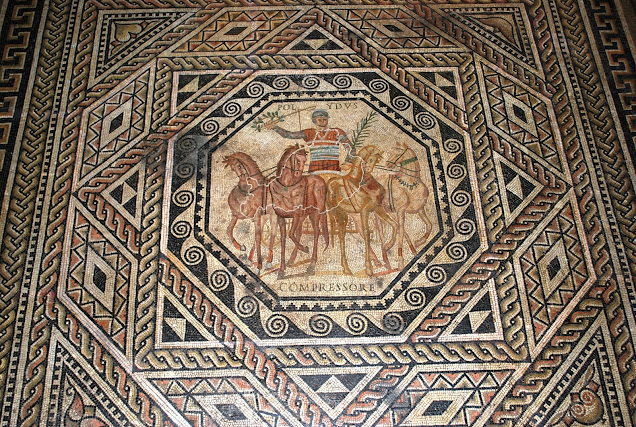Polydus, champion charioteer for the reds
Last week, I visited Landesmuseum Trier for the third time, which probably sounds boring but its collection is of great quality. The museum was renovated a few years ago, so a good excuse to visit it again.
In my previous blog post I already wrote that the circus of Colonia Augusta Treverorum dates back to the earliest period of the cities history. The race track may have been created immediately after the city was founded. Quite some interesting finds, referring to the circus are in Landesmuseum Trier on display, including this mosaic of Polydus, a popular charioteer for the red faction (factio russata), and his lead horse Compressor. He is taking a victory lap. My picture is the centerpiece of a mosaic floor from a villa in front of the Imperial Baths in Trier.
The representations on Roman mosaics of the victorious charioteer of the circus may be compared with similar representations in other forms of Roman art, both major and minor. Certain standard types were established and repeated with only slight variations in different media and at widely different times and places. But individual craftsmen or workshops evidently exercised their own choice over the details.
Here we see Polydus driving his quadriga in profile, at a walk and at the same turning his face to the observer. He has a victory palm in his right hand. This image is regarded the most common type, with the horses arranged schematically to left and right. It is first found in the mid-third century, but becomes especially common in the fourth century and later. The significance of the charioteer is as an image of victory, as a bringer of good luck and felicitas. Polydus was a champion of the red faction, wearing a red tunica, but all four factions (so red, but also green, blue and white) were simultaneously shown as victors.
Note that the mosaic is standing vertically against the wall and my picture only shows the centerpiece. It is dated 250 AD.
In my previous blog post I already wrote that the circus of Colonia Augusta Treverorum dates back to the earliest period of the cities history. The race track may have been created immediately after the city was founded. Quite some interesting finds, referring to the circus are in Landesmuseum Trier on display, including this mosaic of Polydus, a popular charioteer for the red faction (factio russata), and his lead horse Compressor. He is taking a victory lap. My picture is the centerpiece of a mosaic floor from a villa in front of the Imperial Baths in Trier.
The representations on Roman mosaics of the victorious charioteer of the circus may be compared with similar representations in other forms of Roman art, both major and minor. Certain standard types were established and repeated with only slight variations in different media and at widely different times and places. But individual craftsmen or workshops evidently exercised their own choice over the details.
Here we see Polydus driving his quadriga in profile, at a walk and at the same turning his face to the observer. He has a victory palm in his right hand. This image is regarded the most common type, with the horses arranged schematically to left and right. It is first found in the mid-third century, but becomes especially common in the fourth century and later. The significance of the charioteer is as an image of victory, as a bringer of good luck and felicitas. Polydus was a champion of the red faction, wearing a red tunica, but all four factions (so red, but also green, blue and white) were simultaneously shown as victors.
Note that the mosaic is standing vertically against the wall and my picture only shows the centerpiece. It is dated 250 AD.



Deze reactie is verwijderd door een blogbeheerder.
BeantwoordenVerwijderen